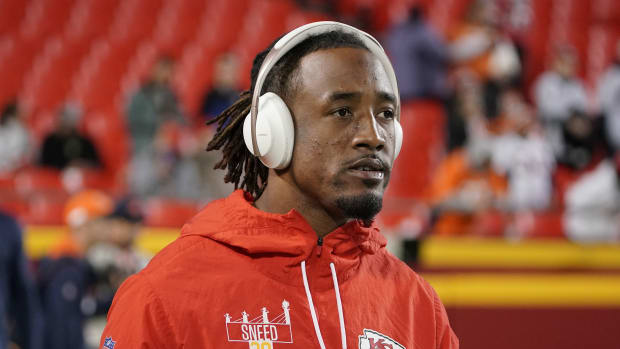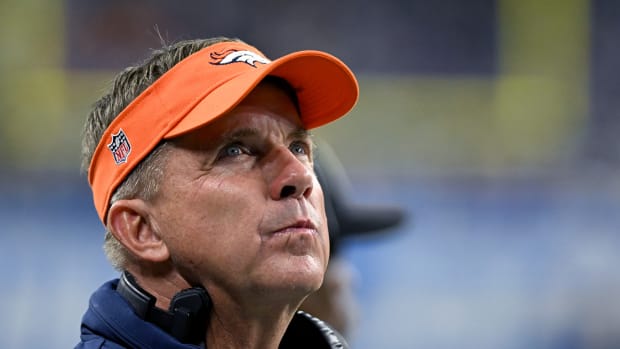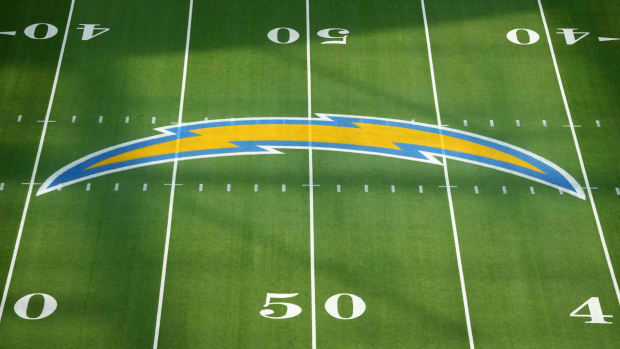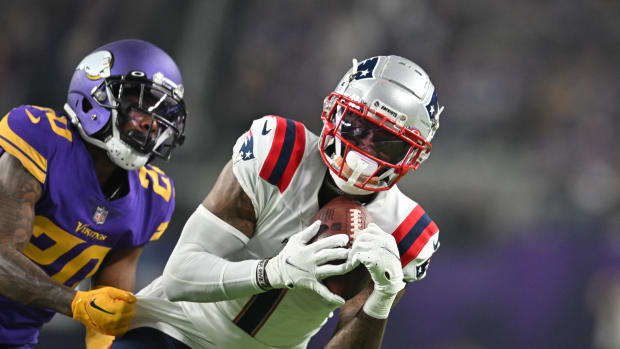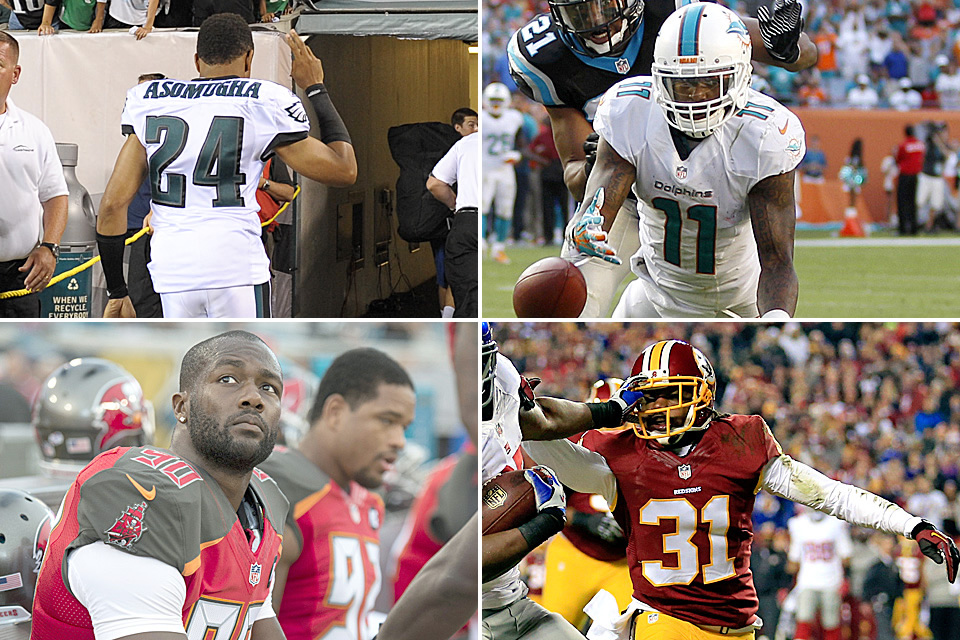
How To Win Free Agency: Don’t Play
In the summer of 2011, the NFL was just back from a player lockout, and the Philadelphia Eagles attacked free agency unlike any other team in the league. Though they’d made the playoffs two straight years, the Eagles viewed having cap room—while so many other teams were snug up against the league’s $120-million cap—as a chance to acquire top talent at Walmart prices.
Michael Vick was re-signed to a back-loaded five-year, $80 million deal to be the quarterback of the future—and Vince Young was imported to back him up. Ronnie Brown was signed to buttress the running game, and Steve Smith (the younger) got signed away from the rival Giants to be another receiving target for Vick. Pass-rusher Jason Babin was signed, as were Dominique Rodgers-Cromartie and Nnamdi Asomugha, forming what was seen as one of the best pass-coverage units in the league.
“The cap for the rest of us is $120 million,” one GM said to me on my trip to NFL training camps that summer. “It feels like it’s $220 million for them.”
As we all know, the spree was part of the Eagles’ downfall that led to Andy Reid’s firing and Chip Kelly’s hiring. More significantly for football, it showed that even the smart teams sometimes get seduced by the siren song of free agency. That’s what free agency is: a drug. It looks like a legitimate quick fix, but there are very few quick fixes in football. Who’d have thought Asomugha would tank, Vick would backslide significantly, and the Dream Team class (Vince Young’s words) would fail?
“As our experience shows,” former Eagles president Joe Banner said Monday, “there are lots of unknowns in free agency. They’re not your own players, and you don’t really know them the way you know your own guys. My advice now is, Proceed with caution. It’s a total crapshoot.”
Joe Banner on Chip Kelly
Former Browns and Eagles president Joe Banner assesses the flurry of roster-overhauling moves made by Philadephia coach Chip Kelly, points out the importance of Kelly's sports science work and addresses his own NFL future. FULL STORY
Which bodes ill for this year’s wild spenders—the Jets, Eagles (again), Dolphins, Jaguars and Titans—as we reach the end of free agency’s first week. Hold onto your calculators. Each of those five teams, according to published contract figures, has committed more than $100 million to free agents. On average, those five teams have spent $134 million on new contracts for unrestricted players on the market.
It’s an annual rite of spring—or of late winter: NFL teams trip all over themselves spending money on free agents. They do it even though, year after year, mounting evidence suggests (no, proves) that the free spending doesn’t result in more wins. It’s indisputable. With the exception of the occasional legitimate star player with good years left—Julius Peppers to Chicago in 2010, Peyton Manning to Denver in 2012, Mario Williams to Buffalo in 2012—going nuts in free agency has proved to be a negative in recent years.
This is not going to be a survey of every free-agent signing in the 22-year history of the system, since Reggie White took $17 million from Green Bay to leave Philadelphia in 1993. It’s more anecdotal. But the anecdotes shout.
Let’s look at seven teams, between 2010 and 2014, that invested the heaviest in free-agency in a given off-season, and see the results.
* Only one season post-spending
The most damning bit of evidence about these eight cases: In the combined 14 seasons after the teams' spending sprees (two apiece for the first six teams, and one season each for the 2014 teams), there were only three playoff seasons—Washington made it in Griffin’s rookie year, 2012, and Denver made it in both of Manning’s first two seasons as a Bronco. But neither Washington nor Denver made the playoffs because of brilliant free-agency spending. They made it because they had quarterbacks.
You can easily make the argument that the common thread in these instances is the lack of established, successful quarterback. You don’t solve your problem at quarterback by paying Carl Nicks $9.5 million a year.
How exactly do you solve the problem? Two ways: You get a quarterback. And you learn to say no.
* * *
The MMQB Roundtable
The NFL is still reverberating from the frantic series of signings, trades and retirements that marked the official opening of the league year. Our staffers debate the reasons, look at who’s done well (Raiders!) and project what’s still to come FULL STORY
The Ravens took a social-media beating from some of their fans last week for, again, sitting out the early days of free agency and letting some significant players—wideout Torrey Smith (San Francisco) and pass-rusher Pernell McPhee (Chicago)—walk away. When Haloti Ngata balked at doing a new contract with a year left on his rich deal, Baltimore dealt him to Detroit for two mid-round picks. Baltimore GM Ozzie Newsome and his staff have gotten used to criticism for letting big names go at this time of year. They don’t seem to mind.
Newsome declined to speak about Baltimore’s free-agent strategy on Monday, or to make anyone else available to discuss it. I think there’s a good chance he stayed mum because it’s a competitive issue to them. The Ravens just do free agency smarter than almost everyone else. They do it by mostly sitting out the early days and allowing bottom-feeding teams to spend the silly money. Occasionally they’ll “splurge” (well, their version of “splurging”) by signing a player like Justin Forsett for reasonable money. Forsett, who walked off the street to gain 1,266 rushing yards for Baltimore last fall, earned a three-year, $9-million deal from the Ravens last week.
But mostly, Baltimore has a history of letting players strike it rich somewhere else and relying on their farm system to replenish what they’ve lost. Maybe this is why Newsome isn’t speaking about the Ravens’ philosophy: It’s a competitive advantage to have teams throwing big money at free-agents, because sooner or later some of that money is going to be spent on Ravens free agents… and that’s going to lead to Baltimore piling up more of what they value highly: compensatory draft picks.
The compensatory-pick system was born in 1994, with the advent of free agency. If a team loses a player for big money, the losing team will—depending on its standing in a byzantine formula—get a mid- to late-round draft choice back the following year to compensate for the loss of the player. The formula for compensatory picks isn’t publicized, but basically it’s this: At the end of each season, the league figures out the free-agency quotient for each team. On one side of the ledger is number of players lost plus total value of contracts signed by those free agents plus playing time by lost free agents in their first year gone. On the other side of the ledger is number of free agents signed plus contract value plus playing time of signed players.
The Ravens had a league-high four compensatory picks—the league’s annual limit—in both the 2013 and the 2014 drafts. They expect to get compensatory picks for the departed Arthur Jones, Corey Graham, Michael Oher and Ed Dickson in this year’s draft. Overall, Baltimore has been awarded more of the extra picks, 41, than any other team in the league. Dallas and Green Bay are next with 33.
“Relying on compensatory picks is a bad strategy,” said Banner, “unless you prove you can draft pretty well in rounds four through seven. Ozzie surely has proven that. But there are some teams out there that struggle to pick well in rounds one and two. Baltimore’s proven the worth of it because when they lose guys, they have players ready to step in—and some of these, obviously, come from compensatory picks.”
The Wizardry of Ozzie
After the Ravens’ Super Bowl win, Greg Bedard examined the secrets to Ozzie Newsome’s team-building strategy, as related by the men who know him best. FULL STORY
There is strength in numbers. As Jimmy Johnson used to say, having more draft picks is insurance against mistakes—because no matter how good a personnel man you are, you’re going to blow some picks. Having consistent depth of draft choices has helped Baltimore win two Super Bowls this century. Their 82 wins (including playoffs) since 2008 are the second-most in the NFL over the last seven seasons.
In free agency three years ago, the Ravens let defensive tackle Cory Redding—a good contributor, not a star—go to Indianapolis. Redding played for the Ravens for two years. When he left, the league gave Baltimore a fifth-round pick in the 2013 draft. That pick turned out to be the 168th overall choice, and Baltimore selected Wisconsin tackle Rick Wagner. At the end of the 2013 season, Baltimore decided to let starting right tackle Michael Oher leave in free agency; he signed with Tennessee. Wagner stepped in to play right tackle, and the moral of the story is a very instructive one. Wagner is a better right tackle than Oher was—last season, Pro Football Focus rated Wagner the No. 2 right tackle in the league. And with the compensatory pick the Ravens will get for Oher—I’m projecting it to be a fifth-rounder—Baltimore will further replenish their farm system. Now, not all picks work out. Baltimore has its clunkers. But it works enough that Newsome aggressively seeks out the extra picks, and he has built substantially with them.
I’ve attempted to show what I believe the Ravens will have in compensatory picks and regular picks this year. Again: This is not gospel, just my best guess based on the history of the compensatory-pick system and what Baltimore lost in free agency in 2014. Compensatory picks noted in italic:
Round 1: own
Round 2: own
Round 3: own
Round 4: own
Round 4: Acquired in trade for Haloti Ngata, 2015
Round 4: Compensatory pick for Arthur Jones to Colts (2014 UFA)
Round 5: Acquired in trade for Ngata
Round 5: Compensatory pick for Corey Graham to Bills (2014 UFA)
Round 5: Compensatory pick for Michael Oher to Titans (2014 UFA)
Round 6: own
Round 6: Acquired from Dallas in Rolando McClain trade
Round 7: Compensatory pick for Ed Dickson to Panthers (2014 UFA)
Seven rounds, 12 picks. You’ve got to like your odds to hit on four or five of the picks between rounds four and seven, based on Baltimore’s history. Of course, the Ravens will have to replace the stalwart Ngata, much more of a core player than the others they’ve lost in recent years, and they need to do it with some depth behind big-bodied Timmy Jernigan, who will get the first chance to win the defensive tackle job left by Ngata.
* * *
The Dwan Edwards pick in 2004 is the gift that keeps on giving for Baltimore. (Larry French/Getty Images)
Compensatory picks can have long tributaries. But to see the impact of them, I wanted to trace one that seemed particularly impactful to the modern-day Ravens. For that we need to go back to the 2004 draft.
Here’s how the Ravens have made the compensatory pick the gift that keeps on giving.
Round 2, overall pick 51, 2004. Ravens select defensive tackle Dwan Edwards from Oregon State. He was a part-time starter for Baltimore until leaving in free agency for Buffalo in 2010, signing a four-year, $18 million contract with the Bills. Baltimore had a surplus of young defensive linemen in 2010—Ngata, Terrence Cody, Arthur Jones—along with veteran Kelly Gregg.
Round 5, overall pick 165, 2011. With the compensatory pick awarded for the loss of Edwards to Buffalo a year earlier, the Ravens took defensive end Pernell McPhee from Mississippi. After recording 17 sacks in four seasons mostly coming off the bench for Baltimore, McPhee last week signed a five-year, $39 million deal with Chicago.
Round 3 or 4, overall pick TBA, 2016. The Ravens will use a compensatory pick acquired for the loss of McPhee to fill some roster hole or other—as they did with 2013 fourth-round compensatory pick Kyle Juszczyk, the Harvard fullback, or 2008 third-round compensatory pick Oniel Cousins, the offensive lineman from Texas-El Paso. Not stars, most likely, but contributing players for a while. That’s what builds football teams down to the 53rd man.
Summing up: For the 51st pick in the 2004 draft, Baltimore got a combined nine seasons and 116 games of front-seven contributions from Edwards and McPhee—and next year they will select another player in the middle of the draft who, if he makes it, the team can control for four years at a reasonable salary (say, four years and $2.5 million).
It’s a smart system, even if it doesn’t look like it when your own free agents are flying out the window in March. But if you have patience, the thick skin to take criticism from fans and media for doing nothing, a good quarterback and a smart front office, you can profit from the system. Beyond Baltimore, there aren’t many teams trying.
Photo credits for top picture: Drew Hallowell/Getty Images (Asomugha); Lynne Sladky/AP (Wallace); Gary Bogdon/SI/The MMQB (Johnson); Robb Carr/Getty Images (Meriweather)
Follow The MMQB on Facebook, Twitter and Instagram.
[widget widget_name="SI Newsletter Widget”]





































